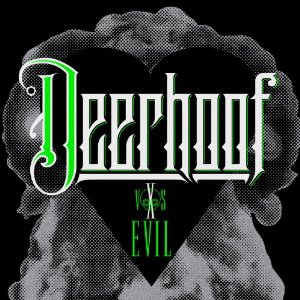Twisting, cranking, screeching sub-funk; metallic jangle pop; biting electronica; sharp and edgy, brilliant and daft, intelligent and joyous! As Amazon may state… "if you like this you may like… er… er" God knows, frankly, although it impossible to listen deeply to Deerhoof vs Evil without recalling evenings of Beefheartian vision or, and at the same time, icy chunks of the more extreme Radiohead, shards of Can, touches of Miles Davis circa Sketches of Spain and then, perhaps, the noises of arcade games and wild city centres. For this is urban music, that much seems obvious. Indeed, that is the only obvious thing here. For, in the Deerhoof world, to be tranquil is to not exist. All life is noise,
Hard to believe that 16 years – and 11 albums – have passed since Deerhoof emerged ferociously from San Francisco’s Bay area. Once they were a duo and profoundly ‘of’ that splintered scene. Today, however, the four band members are scattered across the world with singer Satomi Matsuzaki residing in Tokyo while the others are housed in New York, Oregon and Wisconsin. This distance is significant, for Deerhoof were once ganglike and close… but this bonhomie started to threaten the creativity, and their 2004 album, Milk Man seemed particularly fused to a bunker-mentality. Partly because of this, it became their most successful to date, although many of their devoted followers refused to accept it as the finest. The debate rages and, to those involved, it all seems so incredibly important. To outsiders – who have included yours truly, until recently – it all seems simply bewildering.
("Who would be a Deerhoof fan?" one might reasonably ask. I have no idea though it seems significant to note that the two people I know personally who openly ‘get’ this band, are both gadgety graphics types prone to iPad tinkering and reading Monocle magazine. Not sure that mini survey is particularly conclusive).
What happens on Deerhoof vs Evil is truly fascinating. While not immediately accessible it is, however, infectious and weirdly addictive. Matsuzaki’s vocals often appear to belong to a completely different song, as she sweetly surfs the dips and pops and peaks and deep, deep valleys. In places, she seems blissfully unaware that the music has become lost in a sudden violent swerve. Then again, she also supplies the bass lines, (well, mostly, there is an element of instrument swapping here and one longs to see just how they could replicate this in a live situation). But at least her vocals provide some kind of unifying point. Without it, one senses, this music would fragment even further and become largely unidentifiable. The comparison with Beefheart is not as lazy as you may think. Similar to the Magic Band, the instrumentation can even seem conservative…all of which helps make something – for better or worse – truly unique.
The glue that binds these 12 songs so firmly, however, is not that crazy sweet voice, but a constant and underlining intensity. So powerful, in fact, that it reminds me of gypsy funk and yes, there is a certain sexuality in evidence that one wouldn’t normally associate with off-kilter warped and insane metallic noise. That is where the similarity ends, for Gypsy Funk easily translates into sex-fuelled dance whereas, one might be foolish to even attempt a Deerhoof dance. (My back certainly wouldn’t stand it). However, the trick is allowed the music to interact with you while you are in the process of doing something else. For once, I approve of iPod usage here – though you may wish to soften it by scattering across the shuffle – and I found it uplifting indeed to have this swirling through my head while idling through the Warrington Waterstones. It lifted me to a place that, for reasons which remain unclear, seemed rather whimsical. Back at home, the effect was gentler, although I did feel it necessary to leave the room and allow the music to seep into the wall.
So what is this intriguing warmth one finds with Deerhoof? Maybe my two slightly nerdy pals gave me the wrong signals. For this is not some head-hurting mathematical sound exercise at all. Instead, it’s a very natural and human sound; a four-way chemistry. Indeed, that, and for reasons that may well be lost on the band themselves, certainly works to illuminating effect.
For clues one might scan the titles. They are never less than fun. ‘Super Duper Rescue Heads’, ‘Behold a Marvel in the Darkness’ and ‘Almost Everyone, Almost Always’ seem to convey more than a degree of inventive humour. Whether this is reflected in the songs themselves might be a matter for some debate, for I suspect – as with the daft title – a bit of mischievous messing. All four members of Deerhoof apparently contribute to the ‘lyrics’, even to the extent of throwing in random words, and the same tactic seems to be deployed with the music. The aforementioned instrument swapping is not as deft as, say, Arcade Fire. Indeed, it sits closer to any version of The Fall attempting to play through Mark E Smith’s despotic tinkering. If nothing else it adds a certain frisson, bite and edge. And edge is the key. The danger is that it can induce a kind of ‘mad-cat’ paranoia in the unsuspecting gentle soul. If you can dig beyond that and start to wander about in these random corridors of surging noise, you will find the abstraction truly uplifting.


